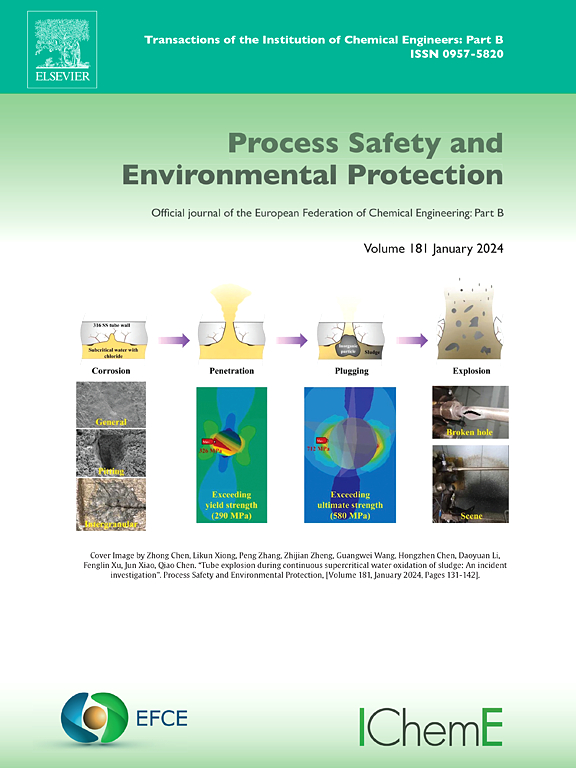Mechanism study and thermodynamic analysis of iron recovery from Sulfuric acid slag by suspension magnetization roasting and magnetic separation
IF 6.9
2区 环境科学与生态学
Q1 ENGINEERING, CHEMICAL
引用次数: 0
Abstract
Sulfuric acid slag, a byproduct derived from the oxidation roasting of pyrite in sulfuric acid production, constitutes a promising secondary iron resource with substantial recycling potential and wide-ranging industrial applications. However, inadequate recycling of this slag may lead to significant environmental degradation and pose serious risks to human health. In this study, an innovative suspended magnetization roasting-magnetic separation (SR-MS) process is proposed for the efficient recovery of iron from sulfuric acid slag. The iron phase transformation behavior of the slag in the reduction/magnetization process was systematically investigated through thermodynamic analysis. Key process parameters were optimized to achieve enhanced iron recovery efficiency, yielding optimal experimental conditions and high-quality iron-rich products. When the calcination temperature was 525 °C, the reducing agent concentration was 30 % (CO:H2=1:3), the roasting time was 20 min, and the magnetic separator field intensity was 1200 Oe, the concentrate iron grade was 63.24 % and the iron recovery rate was 92.20 %. Under a calcination condition of 525 °C, with reducing agent dosage maintained at 30 % (CO:H2=1:3) and roasting duration fixed at 20 min, magnetic separation conducted under 1200 Oe field strength yielded concentrate with 63.24 % Fe content alongside 92.20 % metal recovery. The mechanism was studied by chemical multi-element analysis, phase analysis, VSM analysis and SEM analysis of the slag samples in each stage of the suspension magnetization roasting-magnetic separation (SR-MS) process. It was found that through suspension magnetization roasting (SMR) pretreatment, hematite almost transformed into magnetite with greater magnetism, and microscopic morphology observation revealed significant changes on its mineral surface. The Suspension Magnetization Roasting (SMR) technique not only modifies the physicochemical surface properties of materials, but more significantly induces microstructural reorganization through crack propagation and pore evolution mechanisms. This structural transformation substantially enhances pore distribution characteristics, manifesting as measurable expansion in specific surface area and stepwise increase in total pore volume. The demonstrated that the raw slag is transformed into magnetite. The phase transition from hematite to magnetite during roasting was confirmed through FT-IR spectroscopic analysis. These findings provide critical insights for advancing research and development in sustainable iron resource recycling and innovative solid waste disposal technologies.
悬浮磁化焙烧-磁选法回收硫酸渣中铁的机理研究及热力学分析
硫酸渣是硫酸生产过程中黄铁矿氧化焙烧的副产物,是一种极具回收利用潜力的二次铁资源,具有广泛的工业应用前景。然而,这种矿渣的不充分回收可能导致严重的环境退化,并对人类健康构成严重风险。本研究提出了一种创新的悬浮磁化焙烧-磁选(SR-MS)工艺,用于从硫酸渣中高效回收铁。通过热力学分析,系统地研究了还原/磁化过程中炉渣的铁相变行为。对关键工艺参数进行了优化,提高了铁回收率,获得了最佳的实验条件和高质量的富铁产品。当焙烧温度为525℃,还原剂浓度为30 % (CO:H2=1:3),焙烧时间为20 min,磁选机磁场强度为1200 Oe时,精矿铁品位为63.24 %,铁回收率为92.20 %。在525℃、还原剂用量为30 % (CO:H2=1:3)、焙烧时间为20 min的条件下,在1200 Oe场强条件下进行磁选,精矿铁含量为63.24 %,金属回收率为92.20 %。通过对悬浮磁化焙烧-磁选(SR-MS)过程各阶段炉渣样品的化学多元素分析、物相分析、VSM分析和SEM分析,对其机理进行了研究。研究发现,经过悬浮磁化焙烧(SMR)预处理,赤铁矿几乎转化为磁性更强的磁铁矿,其矿物表面形貌发生了显著变化。悬浮磁化焙烧(SMR)技术不仅改变了材料的表面物理化学性质,更重要的是通过裂纹扩展和孔隙演化机制诱导微观组织重组。这种结构转变大大增强了孔隙分布特征,表现为可测量的比表面积膨胀和总孔隙体积逐步增加。结果表明,原渣转化为磁铁矿。通过红外光谱分析证实了焙烧过程中赤铁矿向磁铁矿的相变。这些发现为推进可持续铁资源回收和创新固体废物处理技术的研究和开发提供了重要见解。
本文章由计算机程序翻译,如有差异,请以英文原文为准。
求助全文
约1分钟内获得全文
求助全文
来源期刊

Process Safety and Environmental Protection
环境科学-工程:化工
CiteScore
11.40
自引率
15.40%
发文量
929
审稿时长
8.0 months
期刊介绍:
The Process Safety and Environmental Protection (PSEP) journal is a leading international publication that focuses on the publication of high-quality, original research papers in the field of engineering, specifically those related to the safety of industrial processes and environmental protection. The journal encourages submissions that present new developments in safety and environmental aspects, particularly those that show how research findings can be applied in process engineering design and practice.
PSEP is particularly interested in research that brings fresh perspectives to established engineering principles, identifies unsolved problems, or suggests directions for future research. The journal also values contributions that push the boundaries of traditional engineering and welcomes multidisciplinary papers.
PSEP's articles are abstracted and indexed by a range of databases and services, which helps to ensure that the journal's research is accessible and recognized in the academic and professional communities. These databases include ANTE, Chemical Abstracts, Chemical Hazards in Industry, Current Contents, Elsevier Engineering Information database, Pascal Francis, Web of Science, Scopus, Engineering Information Database EnCompass LIT (Elsevier), and INSPEC. This wide coverage facilitates the dissemination of the journal's content to a global audience interested in process safety and environmental engineering.
 求助内容:
求助内容: 应助结果提醒方式:
应助结果提醒方式:


